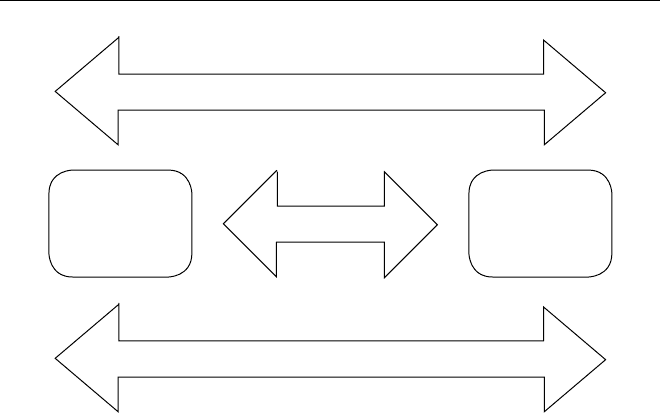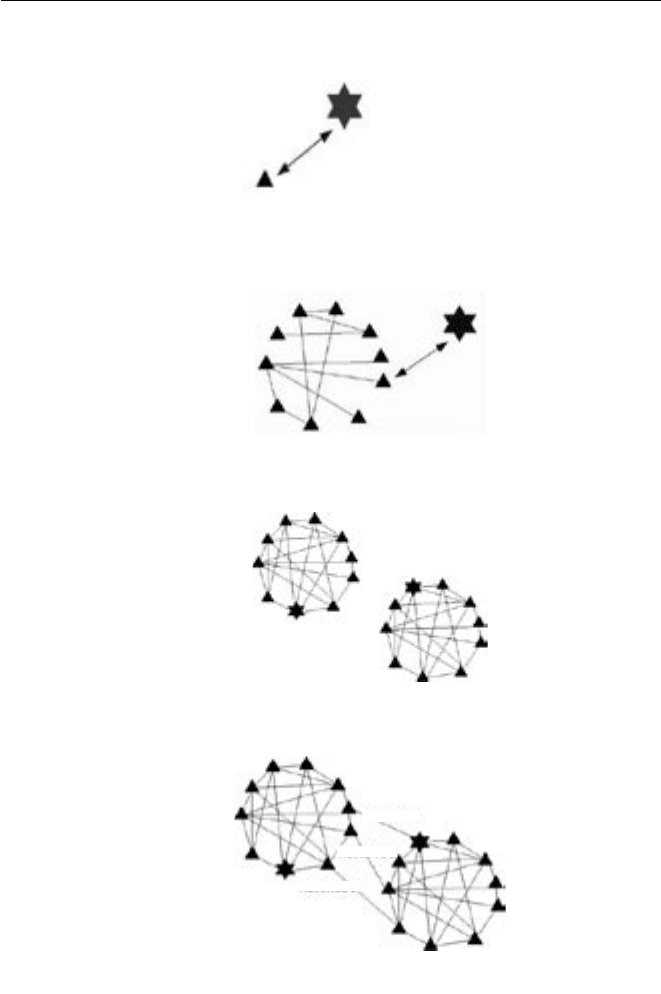Phillips D., Young P. Online Public Relations
Подождите немного. Документ загружается.


A shift in culture, communication and value
56
richness and reach can be identified and evaluated in a wide variety of
ways. The richness of information will be monitored by communication
experts using analysis of websites, monitoring Usenet, blogs and tags about
the organization, its issues and brands, and people in online community
portals from YouTube to Digg and beyond.
In public relations there is a need be involved in two areas of richness
development. This first, needless to say, is in the creation of rich content.
Words, pictures, videos, diagrams, voice and music all add to the richness
available to the public and internet technologies. This is very different from
advertising, which does not have much by way of ‘richness’ as it seeks to
gain reach through media like newspapers and posters.
The second area is the engagement of people who will add to richness
in their own online communities and thereby add both richness and reach
in a symbiotic process. This is achieved in a number of ways. It may be
through their creation of and participation in forums, discussion lists, blogs,
chat or wikis among the many channels that are available. In addition it
can be through the development of online resources that make content
transparently available, using technologies like search engine optimization,
RSS, mashups and tagging.
REACH
Reach is achieved in many ways. Of course there is the business of mak-
ing web presence evident to people seeking information. Techniques like
hyperlink exchange, search engine optimization, affiliate programs and
online and offline advertising are common (and frequently essential) in
practice.
In addition there is the engagement of the online community that brings
people close to the organization by way of visiting the organization’s web-
site, premises or commercial and other products, brands and information
partners. Reach is o�en developed by being part of existing or developing
conversations among the many communities that develop online.
Richness and reach are important elements in developing competitive
corporate transparency.

Richness and reach
57
IN BRIEF
Richness and reach offer transparent information to online
communities.
Richness is provided by organizations and many other online actors.
Along with online contributions, many organizations gain competitive
advantage from the combination of user-generated richness and
reach.
PR practitioners create rich content and engage others to add richness
in a symbiotic process.
Richness and reach are used to promote competitive corporate
transparency.

58
New models
of information
exchange
The more we look at the many aspects of internet-mediated public relations,
the more it seems that someone has sneaked into the place where they keep
the management, public relations and marketing rulebooks and scribbled
on most of the pages.
In their traditional role, public and stakeholder relations created under-
standing of the culture or context for a company or organization. People
‘understood where they were’. This relationship, largely cra�ed by compan-
ies and other organizations (politicians, churches, civil service, charities
and non-governmental organizations, etc), created an environment that
allowed a company (or organization) to effectively promote its products
and services. This created context and public knowledge and (sometimes)
an empathy with the public. Within this context, advertising and marketing
promoted products and services to achieve sales. The chain of supply,
production, distribution and payment process took over and distributed
the product or service (Figure 7.1). It was simple.
This process is now changed – someone has scribbled in the book! The
public relations contribution is now increasingly subsumed into an internet-
driven context. This conquest is both overt and hidden.
7

New models of information exchange
59
The overt presence (promotion and interaction between an organization
and its constituency) is now largely transparent. This is because of the influ-
ence of websites, online news distribution, web marketing, and relation-
ships with market makers, auctions and marketing groups in business-to-
consumer and business-to-business environments. The subliminal influence
of the internet, as the means by which an organization is evident in the
human (and machine) context, is not difficult to uncover.
The presence of information and messages about organizations is spread
by and through many devices, platforms that transmit and receive informa-
tion like PCs, laptops, mobile phones, iPhones and MP3 players, USB sticks,
CDs and DVDs, games machines and, among many more, even satellite
navigation devices. Distribution is effected by web crawlers and search
engines and directories, with re-distribution of news and press releases,
newsgroup conversations, chat, personal and corporate websites and much
more. Even tracking a new message in cyberspace is daunting. Tracking all
the messages, new and old, is probably already too difficult. The internet
is thereby ‘in charge’ of creating the context in which an organization is
evident to a broad constituency (see Figure 7.2).
A simple example helps explain this phenomenon. In 2007, somewhere
in the visible part of the internet, there were 300,000 web pages that refer-
ence the Chartered Institute of Public Relations and they were generally
available to the public. This is an institute asset of 300,000 impressions on
the web. The Institute had just over 3,000 web pages available on its website
Marketing
Logistics
CustomerSupplier
Public relations
Figure 7.1 The chain of supply, production, distribution and payment process
© David Phillips (1999) The Traditional Information Value Chain.

A shift in culture, communication and value
60
Figure 7.2 How information moves through the internet
Source: Alison Clark, CIPR/PRCA Internet Commission, 2000
A message is made electronic
It goes into a network
All networks are connected
Control over the message is lost
Always!
A message is made electronic
It goes into a network
All networks are connected
Control over the message is lost
Always!
MESSAGE 2
MESSAGE 1
MESSAGE 3

New models of information exchange
61
The vast majority of pages online were not under the direct control of the
Institute. Most had not been created by it. The Institute was probably not
aware of the majority of the pages that reference it. In fact, most content
available to the public about the Chartered Institute of Public Relations was
created by third parties of whom the Institute is probably not aware.
The context in which the Institute is evident online has been provided by
those people and organizations that reference it. The vast majority are in no
way influenced by the Institute and there is no means by which the Institute
can influence them all. The internet is in charge of creating the context in
which the Institute is evident online.
This applies to almost every organization in the internet-developed
world. Such change is of the internet. There is more. This change is also af-
fecting the ‘traditional’ context more than most understand.
Because a large part of the physical world is now dependent on informa-
tion delivered across the internet via websites, e-mail, blogs, wikis and
internet-enabled electronic data interchange (EDI), and through a range of
devices, the once separate relationship between traditional and internet-
driven relationships has gone. For example, reporters and news providers
have become heavily dependent on the internet, which leads one to ask
how much ‘traditional’ newspaper readers are reading internet-driven
news by proxy.
1
Traditional banks, recruitment agencies, estate agents,
lawyers (the list is too long to enumerate) and more now depend on the
and held in search engine caches, and there were 13,000 web pages that
referenced the Institute’s URLs. All of this information was available using
devices like PCs, laptops and mobile phones (in May 2008 over 16 million
people accessed the mobile internet by using their mobile phone or mobile
device in the United Kingdom).
The new generation of microchips now marketed by companies including
Intel, Nvidia, Samsung and Texas Instruments allow internet connectivity
into just about every kind of electronic device. The use of networks such as
telephone cables, cellular radio, WiFi and WiMax, online all the time and
everywhere is becoming the rule. The wider range of platforms includes
televisions, in-car entertainment systems, hand-held devices, Bluetooth
devices, MP3 players, headsets, electronic hoardings and much, much
more. In 2008, Intel announced a range of new developments in this area,
extending internet penetration into an even wider range of platforms.
Sony’s Reader and iRex’s Iliad both offer very useable, handy, portable,
internet-connected e-books that can accommodate novels and other
books, certainly, but also newspapers, work notes, jottings and so on.

A shift in culture, communication and value
62
internet for information to give them the franchise and authority to operate.
The context by which an organization is known is only as good as its ability
to use the internet and to be part of the internet culture.
New employment dependencies are becoming apparent, such as the
printing, publishing and distribution of books and CDs benefiting from
the online success of Amazon or Barnes and Noble and their competitors.
Indeed, the ability of many organizations to employ people is due to its
ability to optimize its operations using the internet.
Progressively, overtly and subliminally, internet technologies have taken
charge throughout the supply/demand chain, or more appropriately the
value chain, but more significantly throughout the ‘value network’. Now,
whole populations are completely reliant on the workings in cyberspace
– whether they know it or not.
The context in which an organization can thrive is rapidly moving from
its ability to create traditional relationships with publics (public relations)
to its ability to do this in the online world (and mostly via third parties that
are beyond its control). (See Figure 7.3.)
Figure 7.3 The changed context of online relationships
© David Phillips (1999) The New Information Value Network
Transparent specification, design, benefits, brand equity
Transparent cost, prices, availability, responsivenesss
CustomerSupplier
The internet
Stakeholder relationship management
Employee relationship management
The value network, extending upstream to suppliers and downstream to
customers, also includes the value added by third parties to the transaction
as well as other tertiary contributors in a network of networks. They will
to an ever greater extent a�enuate processes, as information flows trans-
parently through the whole of the transaction network.
2
In such a networked

New models of information exchange
63
structure the supplier can be at once customer, partner, social commentator
and commercial foe.
This is starkly shown in the nature of Google advertising. Google
Adwords is a form of advertising that presents advertisements in web
pages. It is easy to deploy and anyone can do so. It is also effective. Many
individuals, companies and advertising agencies (and a lot of PR agencies)
use the service. At the same time, Google Adwords is a customer, supplier
and competitor to the advertising industry. In addition, because Adwords
is presented to the public in context (appropriate advertisements are pres-
ented in the right context when people use the web), it is also a commen-
tator on the relevance of a product or service advertised in the context of the
web page content.
As increasing information volume combines with accessibility, traditional
information intermediaries are threatened. At the same time a growing
number of information partners come into focus, offering a combination of
value added content, enhanced communication facilities, wider reach and
rich relationships for information consumers.
In his book Here Comes EveryBody, Clay Shirkey shows the difference be-
tween the traditional broadcast means of communication and the phenom-
enon of networked communication.
3
Where, for example, newspapers
once distributed news to a mass readership, today there is an alternative
form of news distribution. It is the network of interlinked people passing
on information in their network of friends and acquaintances, whose
members also have networks of additional friends and acquaintances. The
news passes through this network, sometimes fast and unadulterated,
and sometimes both slowly and o�en much changed. The network adds
its own values to the news, and in doing so contributes to alternatives in
public understanding. This process o�en has greater reach than traditional
broadcast news distribution, and all too o�en is faster. This network process,
of which more in Chapter 8, will not replace broadcast news distribution;
they are systems that work side by side. Sometimes they complement each
other and sometimes they present different perspectives.
The practitioner with ‘messages’ to present to a public is now confronted
with this changed communications environment.
In 2008 The Guardian newspaper had a circulation of about 347,000,
including about 44,000 copies sold outside the United Kingdom. The
Guardian website had a daily web audience of about 771,000. Only 37 per
cent of guardian.co.uk web users were in the United Kingdom. The print
and online experiences are fundamentally different: on the web, most
readers tend to focus on a particular section rather than browsing the full
news range. The news section gets most impressions per month (almost 21
million, or 39 per cent of the total), followed by football with 7.2 million,

A shift in culture, communication and value
64
This changed environment would suggest there is a new aspect to public
relations. The practitioner, it seems, now needs to consider the organization’s
internet strategy. This is a discipline beyond the organization’s web pres-
ence, social media presence and local presence, and is a discipline in its
own right.
There is another phenomenon. The internet has added to the range of
communication interactions available to people. We all understand com-
munication between two people as one-to-one communication. This may
be a chat with a mate in the pub or online instant messaging and e-mail.
Great orators, newspaper editors and web masters can address and publish
to mass audiences, which we understand as one-to-many communication.
More difficult is a process of communication when many speak to many. But
with the internet this is possible. It can be achieved by using e-mail and the
writable web, notably wikis, where (in theory at least) anyone can initiate,
write, read, change and comment on any content. The internet facilitates
many-to-many communication. However, it goes further. There is growing
use of many-to-one communication. RSS feeds, by which immediate alerts
wing through cyberspace as soon as the author publishes an article, and the
microblogging service Twi�er are two examples. In the case of the la�er,
developments such as a service called ‘Alert Thingy’ (h�p://aler�hingy.
com/|) continually feed information wri�en by friends on Twi�er, Facebook,
their blogs, FriendFeed and other social media directly to the individual.
Many can and do communicate to one. Many-to-one communication is a
reality and is popular.
Information and knowledge has been accumulating since the beginning
of time, and those who posses this knowledge have an access to power
and riches. This meant that knowledge was jealously guarded, fought over
and o�en destroyed because of its power. Today, because of the nature and
original intent of the internet, knowledge is very difficult to destroy. The
education with 4.2 million, sport with 3.3 million, and arts and media with
about 2.2 million each.
The Guardian had 300 million web page impressions online, which is a
considerable online asset built up since 1996. Of those impressions, and
from a standing start four years earlier, by 2008 over 5 per cent were in
blog posts and other social media that added content to and about the
Guardian and its stories. Most of them were written by the general public
(the Guardian’s own blogging journalists provide only a fraction of these
comments). It is reasonable to posit that, worldwide, there is more daily
third-party comment online about Guardian stories than is represented
in its total print circulation. Print and online broadcast communication sit
side by side with network communication, adding to the total online asset
of the newspaper.

New models of information exchange
65
One of the authors begins teaching his undergraduate courses with the
maxim that: ‘Everything you do and say online is there forever and can be
retrieved moments and decades later to haunt the originator into old age.’
He then invites the audience to recall those oh-so-intimate ‘conversations’
on instant messenger with partners. He relieves the instant ‘group blush’
by saying that it’s a mistake that most make.
Among 50 students in one class in 2006, over 30 changed their Facebook
profile in the following 24 hours.
IN BRIEF
PR, historically, provided the link between supplier and customer.
The overt presence (promotion and interaction between an organ-
ization and its constituency) is now largely transparent across organ-
izations and publics.
The internet is ‘in charge’ of creating the context in which an organ-
ization is evident to a broad constituency.
The context in which an organization is seen online is mostly not under
the control of the organization.
The once separate relationship between traditional and internet-
driven relationships has gone.
The value network, extending upstream to suppliers and down-
stream to customers, also includes the value added by third parties
to the transaction, as well other tertiary contributors in a network of
networks.
Today, there are alternative forms of news distribution.
The practitioner with ‘messages’ to present to a public is now con-
fronted with this changed communications environment.
internet presence of organizations exposes their information globally. It is
packaged and passed, stored (‘cached’) and accumulated on thousands of
computers and accessible in a myriad of ways. It cannot be destroyed.
The nature of information is therefore significant in management of online
relationships and reputation.
Computer-stored information is accessed through over a billion websites,
tens of billions of web pages, e-mails and other access technologies, and
via a myriad of devices. This combination has given immense power to
the communicators because it allows us, as Evans and Wurster show, to
separate things, such as the head office, and information, such as the cor-
porate intranet or wiki, and make the information available to all.
4
